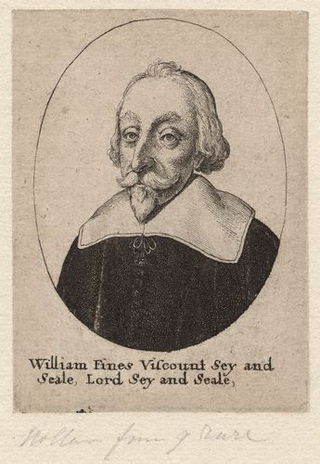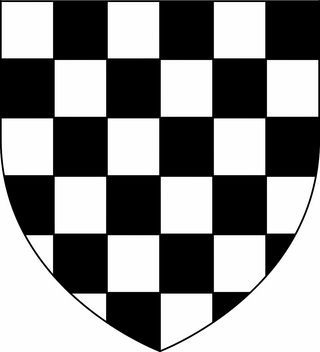Related Research Articles

Viscount Hereford is the oldest extant viscountcy in the Peerage of England, making the holder the Premier Viscount of England. The title was created in 1550 for Walter Devereux, 10th Baron Ferrers of Chartley.

Baron Saye and Sele is a title in the Peerage of England held by the Twisleton-Wykeham-Fiennes family. The title dates to 1447 but it was recreated in 1603. Confusion over the details of the 15th-century title has led to conflicting order for titleholders; authorities such as Burke's Peerage and Debrett's Peerage do not agree on whether or not the 1447 creation is still extant.

Viscount Scarsdale, of Scarsdale in Derbyshire, is a title in the Peerage of the United Kingdom. It was created in 1911 for the prominent Conservative politician and former Viceroy of India George Curzon, 1st Baron Curzon of Kedleston, who was created Earl Curzon of Kedleston at the same time and was later made Marquess Curzon of Kedleston.

William Fiennes, 1st Viscount Saye and Sele was an English nobleman and politician. He was a leading critic of Charles I's rule during the 1620s and 1630s. He was known also for his involvement in several companies for setting up overseas colonies.
Fiennes or Ffiennes may refer to:

The Twisleton-Wykeham-Fiennes Baronetcy, of Banbury in the County of Oxford, is a title in the Baronetage of the United Kingdom. It was created in the 1916 Birthday Honours for the Liberal politician and decorated military officer the Hon. Eustace Twisleton-Wykeham-Fiennes.
Nathaniel Thomas Allen Fiennes, 21st Baron Saye and Sele,, styled as Lord Saye and Sele, was an English peer, businessman, chartered surveyor and army officer.
Geoffrey Cecil Twisleton-Wykeham-Fiennes, 18th Baron Saye and Sele was an English soldier and Liberal politician from the Twisleton-Wykeham-Fiennes family. He served as Comptroller of the Household between 1912 and 1915.

John Fiennes was the third son of Puritan noble and politician William Fiennes, 1st Viscount Saye and Sele. He served in the Parliamentarian army during the First English Civil War, before resigning his commission when elected MP for Morpeth in 1645. Excluded from Parliament by Pride's Purge in December 1648, he largely avoided politics thereafter but was appointed to Cromwell's Upper House in 1658.

James Fiennes, 2nd Viscount Saye and Sele was an English peer and MP at various times between 1625 and 1660, when he succeeded his father and entered the House of Lords.
Theophilus Clinton, 4th Earl of Lincoln, KB, styled Lord Clinton until 1619, was an opponent of Charles I during and preceding the English Civil War.
John Twisleton, of Horsmans Place, Dartford, Kent was created a baronet by the Lord Protector Oliver Cromwell. He was Sheriff of Kent.
The Venerable Frederick Fiennes, 16th Baron Saye and Sele, MA (1799–1887) was Archdeacon of Hereford from 1863 to 1887.
Richard Fiennes, 7th and 1st Baron Saye and Sele was an English peer and diplomat.
Major General Thomas Twisleton, 13th Baron Saye and Sele was a British Army officer and peer.

Sir John St Barbe, 1st Baronet, of Ashington, Somerset and Broadlands, Hampshire, was Member of Parliament for Ilchester in 1681. He was created a baronet on 30 December 1662 at the age of 7.
The Twisleton-Wykeham-Fiennes family are the descendants of the 16th Baron Saye and Sele who was born Frederick Benjamin Twisleton and adopted the surname Twisleton-Wykeham-Fiennes in 1849 by Act of Parliament. He was the grandson of Thomas Twisleton, 13th Baron Saye and Sele and inherited the barony from his first cousin William Thomas Eardley-Twisleton-Fiennes in 1847. The surname is frequently shortened to Fiennes. Members of the family include the explorer Ranulph Fiennes and the actors Ralph Fiennes, Joseph Fiennes, and Hero Fiennes Tiffin.
The High Steward of Banbury is a ceremonial title bestowed by Banbury Town Council in Banbury, Oxfordshire, England.
Ivo Murray Twisleton-Wykeham-Fiennes, 20th Baron Saye and SeleOBEMC was a British peer and army officer.
Martin Guy Fiennes, 22nd Baron Saye and Sele,, styled as Lord Saye and Sele, is an English peer and businessman.